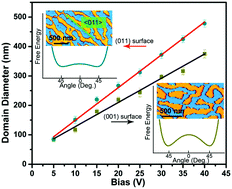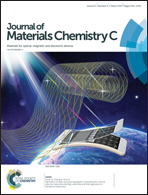Investigation of piezoelectric property and nanodomain structures for PIN–PZ–PMN–PT single crystals as a function of crystallographic orientation and temperature†
Abstract
Pb(In1/2Nb1/2)O3–PbZrO–Pb(Mg1/3Nb2/3)O3–PbTiO3 (PIN–PZ–PMN–PT) quaternary system relaxor ferroelectric materials possess a high ferroelectric phase transition temperature (TFE–FE > 120 °C) due to the enhanced A–B repulsion intensity in the ABO3 lattice caused by the incorporation of In3+ and Zr4+ cations. Due to these additions, excellent piezoelectric property (d33[001]* = 1820 pm V−1) at room temperature and good thermal stability were observed in the PIN–PZ–PMN–PT single crystals. Strong frequency dispersion (frequency ∼0.1–100 kHz) and small short-range correlation length (〈ξ〉 ∼ 118 nm) of polar nanoregions (PNRs) illustrate the high degree of relaxor nature of these quaternary-system single crystals in comparison with the PMN–0.2PT relaxor single crystal (〈ξ〉 ∼ 210 nm). The high relaxor nature is speculated to be caused by In3+ and Zr4+ cations and is considered one of the main reasons for the excellent piezoresponse of the PIN–PZ–PMN–PT single crystal. Moreover, PNRs with orthorhombic 〈011〉 polarization might have a modulation effect on the (011) surface, leading to the anisotropic nanodomain structures. A lower free energy for domain switching on the (011) surface was needed than that on the (001) surface, which was confirmed by the piezoresponse hysteresis loops and local domain poling behavior studies.



 Please wait while we load your content...
Please wait while we load your content...